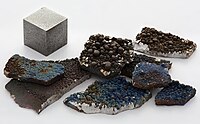
Photo from wikipedia
Abstract To ease environment pressure and improve the comprehensive utilization of titanium slag, Mg doped magnetite nanoparticles (MFNPs) fabricated by recycling of titanium slag via solid-phase reduction roasting technology were… Click to show full abstract
Abstract To ease environment pressure and improve the comprehensive utilization of titanium slag, Mg doped magnetite nanoparticles (MFNPs) fabricated by recycling of titanium slag via solid-phase reduction roasting technology were used as an adsorbing material for treating As(V)-polluted water, and investigated by various analytical techniques. The analysis of the X-ray photoelectron spectroscopy revealed that As(V) ions were partially reduced to As(III) ions by the Fe(II)-MFNPs, and then As(III) and As(V) were adsorbed on the MFNPs through electrostatic attraction, and simultaneously fabricated Fe–O–As via surface complexation. The investigation of As(V) adsorption process on the MFNPs indicated that the as-received equilibrium relationship was well depicted by the Friendlies isotherm model, and the maximum loading capacity of As(V) estimated from Langmuir isotherm model was 33.71 mg/g at ambient temperature. Moreover, the adsorption of As(V) on the MFNPs was accorded with pseudo-second-order kinetic model. The thermodynamics functions manifested that adsorption of As(V) on the MFNPs belonged to spontaneous chemisorption. Desorption of the As(V)-MFNPs was easily performed, with repeated use for at least five cycles. These results indicated that the fabricated MFNPs by reduction roasting technology was functioned as an environmentally friendly adsorbent with promising prospects for arsenic removal from contaminated water.
Journal Title: Journal of Cleaner Production
Year Published: 2020
Link to full text (if available)
Share on Social Media: Sign Up to like & get
recommendations!